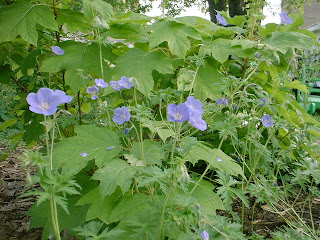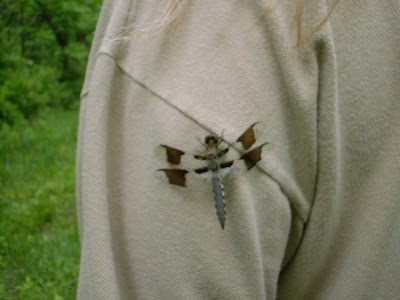Mulch, natural duff, living cover.Much is said about mulching a garden. It seems to be a good way to achieve many objectives.
Clemson factsheetsMulches prevent loss of water from the soil by evaporation.
Organic mulches will absorb some of the water applied or rainfall thereby slowing runoff.
It can reduce the growth of weeds, when the mulch material itself is weed-free and applied deeply enough to prevent weed germination or to smother existing weeds.
It will slow down heating and cooling of the soil. Protecting young plants from heaving in winter and keeping hot sunny days from overheating plant roots.
A mulch will prevent soil splashing, which not only stops erosion but keeps soil-borne diseases from splashing up onto the plants and keeps foliage clean and attractive.
Organic mulches can improve the soil structure. As the mulch decays, the material becomes part of the topsoil. Decaying mulch also adds some nutrients to the soil.
A mulch spread around the base but pulled back from the trunk in a donut like shape can prevent the trunks of trees and shrubs from damage by lawn equipment.
Mulch will help prevent soil compaction.
Plants especially trees and shrubs produce more roots right into the decomposing mulch layer.
In new plantings mulch provides a cover of uniform color and interesting texture to the surface until plants grow enough to provide soil cover.Spending time watching the progress of a large perennial garden will show a gardener just how much mulch plants produce on their own. Lower leaves dry out and fall to the ground, flowers bloom and shed petals, seed pods form and dry out becoming brittle then break off, falling to the soil. In fall the entire mass begins to decompose. The very act of removal of this crisp material sheds organic duff. Leaving this natural mulch was once thought to be harboring disease and pests. But today unless a specific problem arises many think leaving the duff aids the soil.
Trees and shrubs have a similar constant shedding of decaying organic material. The Honey locust standing in our garden starts in spring forming flowers which shed.Then seeds which fall. Leaves and tiny stems cover the ground below in fall. Branches break off in storms, squirrels drop leaf clusters taken for nests. It is constant this debris a tree can produce. Some trees even produce a mass of pollen that is wind blown to cover everything in its path.
So what happens to all that plant produced duff?
In non garden areas it covers the soil decomposing like compost, providing humus for soil organisms and some nutrients to plants. Like the applied mulches it performs all the same services
IF allowed to remain in place. Being neat and tidy as many gardeners are much of this duff is removed .
Then often a uniform mulch replaces the original cover.
Some will plant a living mulch or ground cover and some prefer to cultivate the soil though
bare soil is seldom tolerated by nature or the gardener.
More to think about...
Mulch/waterlosscovercropA two-year study by Agricultural Research Service (ARS) and Iowa State University scientists—described in this month's issue of Environmental Entomology—lent weight to a long-suspected hypothesis. The research showed that predators killed many more pupae of the costly European corn borer in fields hosting the living mulches than in mulch-free plots.
The predators, mostly carabid ground beetles and arachnids, consumed pupae used as "sentinel prey"—that is, prey placed in the field to measure predator activity.
Within the living mulches, predatory insects killed 66 percent of the borer pupae planted in corn—a 51 percent increase over nonmulched control plots—and 65 percent of the pupae in soybeans, 13 percent more than in the control plots.
ARS is the U.S. Department of Agriculture’s chief scientific research agency.
native plant survivalexcerpt...
Leave as much natural duff as possible around the base of individual trees.
Removal of native duff and litter not only disturbs the natural nutrient cycling
which is important for tree growth and survival,but the activity itself may severely
damage roots that are near the ground surface. Additionally, litter removal
contributes to a rise in the temperature of exposed soil,which may have lethal effects on the tree.
On some sandy sites in Florida,soils that were partially shaded by native vegetation have reached temperatures exceeding 165°F.It is highly probable that soils exposed,
due to duff and litter removal,
may reach temperatures that are lethal to many species.
BuffersTrees
This upper canopy intercepts raindrops.
By breaking the fall of these tiny water bombs soil erosion is reduced. Trees provide shoreline habitat for wildlife, shade for your house and keep the water cool. Their deep roots take hold of the soil protecting it from erosion and slumping. Lower tree branches can be trimmed for people who prefer to have an unobstructed view , but the more tree branches the better.
Shrubs
The second obstacle raindrops hit on the way to the ground is shrubs. Shrubs provide wind protection and birds love to take refuge in them. Their roots also hold the soil in place. Shrubs are a great noise barrier and are low growing so they will not obstruct a view.
Groundcovers
Vines, grasses and flowers slow down surface water runoff and absorb nutrients and other non-point source pollution. Their roots hold onto surface sediments. Groundcovers that flower can create accents of color with a variety of green backdrops. They also provide habitat for such insects as butterflies , bees and fireflies.
Duff Layer
Allow vegetation and woody material to stay where it falls. Accumulation of plant matter on the ground acts like a sponge, absorbs water, traps sediment and prevents erosion. Duff hosts microorganisms that improve soil by breaking down and recycling plant material into nutrients to be used in the growth of new plants.
Improved habitat. Buffers provide food and habitat for wildlife. Leaf litter is the base food source for many stream ecosystems, and forests provide woody debris that creates cover and habitat structure for aquatic insects and fish. Riparian corridors preserve important terrestrial habitat, including forest cover. They are important transition zones, rich in species. A mile of stream buffer can provide 25 to 40 acres of habitat. Unbroken stream buffers provide “highways” for migrations of plant and animal populations. Buffers also provide essential habitat for amphibians, which require both aquatic and terrestrial habitats to complete their life cycle. Buffers maintain the base flow of streams
Enhance forests and other natural vegetated areas
Natural vegetation can become an important part of a storm-water management system. Trees and other types of vegetation evapo-transpire at least 40 percent of rainfall. The forest duff layer absorbs large amounts of runoff, releasing it slowly to the streams through shallow groundwater flow. (6) Mature vegetation is also an efficient water quality buffer. Identify and preserve the highest-quality forest stands prior to development. Where possible leave mature trees. (7)
Education and outreachplantpathMulchL

























